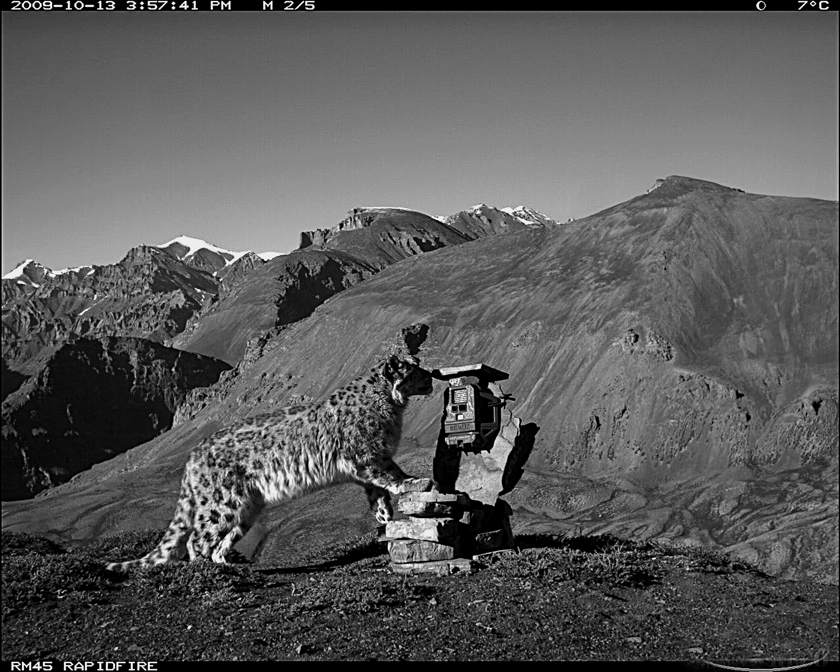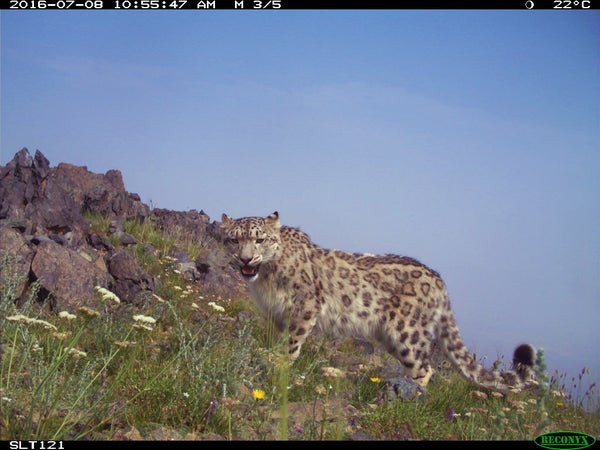Back in 1986 South African biologist Rodney Jackson and his now wife Darla Hillard published three “self-portraits” that would shift the course of conservation. Jackson and Hillard got these images by hiding a camera—equipped with a six-volt battery, flash and pressure pad—in a gorge in Nepal known to be frequented by snow leopards. It took 561 nights to capture three photographs of a species few people had ever set eyes on.
Jackson’s innovation was the first use of a camera trap to monitor wild snow leopards and finally provided researchers with a way to spot the elusive animals and estimate their population size. In 2017 one such estimate—of perhaps 8,000 cats—prompted the International Union for Conservation of Nature to remove the snow leopard from its endangered list, 45 years after it had been included there. The reclassification was controversial, given that camera traps covered only 2 percent of the species’ range—and that the threats of land development, climate change and poaching remained. Now a new study adds another wrinkle to the story by suggesting that camera trap usage may also be inflating population counts of snow leopards and other vulnerable species. This finding could mean “there are fewer snow leopards than we think,” says Örjan Johansson, a biologist at the Swedish University of Agricultural Sciences, who led the study.
Wildlife biologists estimate the number of snow leopards by looking at the spot patterns on their coat, which are as unique as human fingerprints. (The same is true for other big cat markings, such as tigers’ stripes.) The more images show different markings in a given area, the more individuals are inferred to be in that place—or at least that has been the prevailing assumption. But Johansson, who has spent 12 years studying Mongolian snow leopards and is affiliated with the nonprofit Snow Leopard Trust, says such patterns are harder to identify than had been commonly assumed. Different camera angles, light levels and other complications, he explains, can lead to mistaken identifications, making population estimates based on this method essentially “guesswork.”*
On supporting science journalism
If you're enjoying this article, consider supporting our award-winning journalism by subscribing. By purchasing a subscription you are helping to ensure the future of impactful stories about the discoveries and ideas shaping our world today.

Snow leopard inspects a camera trap in India in 2009. Credit: Nature Conservation Foundation India and Snow Leopard Trust
To evaluate the effectiveness of camera traps in identifying individual animals, he and his colleagues used such traps to obtain images of 16 snow leopards in seven European zoos. They showed four trained observers and four nonexperts multiple photographs of each cat and found that both groups often misclassified different images of the same leopard as different individuals. The research, published this month in Scientific Reports, claims camera trap studies overestimate snow leopard populations by 35 percent.
Johansson says he thinks the numbers of tigers, jaguars and other big cats worldwide have also been inflated. “I assume there are errors in all species,” he says.
Other experts agree that concerns about this method of estimating animal populations are likely valid.But they think more studies are needed to see if miscounting is truly a pervasive problem. “Before we can draw any firm conclusions about how accurate photo identification is on average—or for any study—we need more studies like this for many different species and populations of the same species to understand how far the problem extends,” says Fridolin Zimmermann, a biologist at the Swiss nonprofit KORA. He has published a book on best practices for using camera traps and was not involved in the new paper.
Some researchers say there are ways to overcome the problem of misidentified individuals. Marcella J. Kelly, a Virginia Tech wildlife conservationist, who was also not involved in the new study, uses artificial intelligence pattern recognition to differentiate spot patterns in her large databases of jaguars and ocelots. Johansson says he is open to AI but notes that training software to recognize patterns is still a work in progress for some of the same reasons identification by eye is difficult.
Tanya Rosen, a big cat specialist at the United Nations Environment Program’s Vanishing Treasures project, suggests that using more than one camera at a single location could help by providing multiple angles to compare. She was not involved in the new research and thinks that in her work camera trapping snow leopards over the past 12 years, leopard numbers were actually underestimated. When she and her colleagues were uncertain about the identity of a cat, she says, they erred on the side of caution and did not classify it as a different individual.
Johansson hopes researchers can standardize the identification of spots and patterns so that all projects are working from the same starting point. “If you read camera-trapping papers, people are so convinced we can ID individuals. You don’t have to explain how it was done, and there’s never acknowledgement there might be errors,” he says. Lucero Vaca, a zoology Ph.D. candidate at the University of Oxford, who is studying jaguars in Mexico and was not involved in the new work, agrees.“Every time we share our findings, we must be crystal clear of which factors we’re considering when estimating species abundance,” she says. “If not, the final estimate is meaningless—or worse, it can lead to a highly biased decision on a vulnerable species.”
*Editor’s Note (5/4/20): This paragraph has been edited after posting to clarify Örjan Johansson’s opinion.
